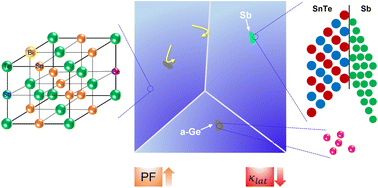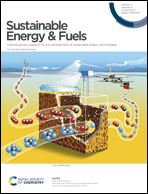Pushing the limit of synergy in SnTe-based thermoelectric materials leading to an ultra-low lattice thermal conductivity and enhanced ZT†
Abstract
In the era of sustainable and environmentally friendly energy requirements, alternative sources of energy continue to be fervently sought after. Heat recovery into useful electrical energy from waste heat offers a readily available source of energy with humongous potential. Herein, a non-toxic thermoelectric material, SnTe, is explored. Promising thermoelectric performance is also communicated. Introducing Ge as a single dopant is shown for the first time in SnTe-based materials to introduce amorphous Ge (a-Ge) precipitates into the matrix. These act as an auxiliary contributor to the observed ultra-low lattice thermal conductivity of ∼0.33 W m−1 K−1 at 823 K, which is below the reported amorphous limit of SnTe. Bi, which is a known resonant dopant, was further co-doped to fine-tune the electrical properties where a high power factor of ∼25.7 μW cm−1 K−2 is reported. To push the limit of synergy, Sb was added raising the maximum figure of merit ZT to a value of ∼1.1 at 873 K. With co-doping, dual resonance levels are shown which distorts the density of states (DOS) contributing to an increased band effective mass. In conjunction with the introduction of an amorphous phase, co-doping is ascertained as a practical means for the synthesis of high-performance thermoelectric materials for effective waste-heat recovery applications.



 Please wait while we load your content...
Please wait while we load your content...